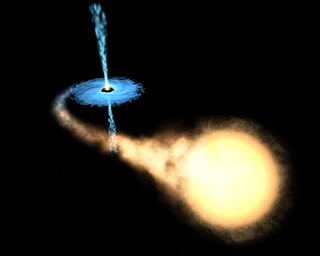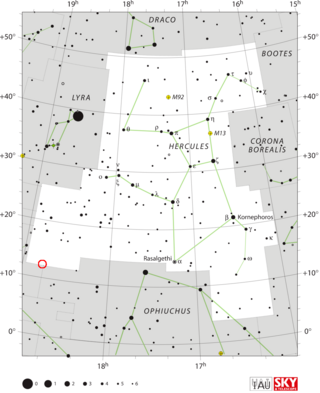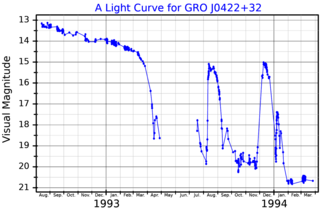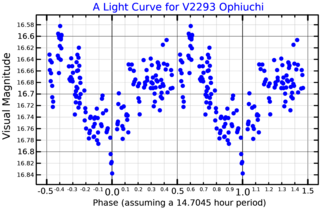
Cygnus X-1 (abbreviated Cyg X-1) is a galactic X-ray source in the constellation Cygnus and was the first such source widely accepted to be a black hole. It was discovered in 1965 during a rocket flight and is one of the strongest X-ray sources detectable from Earth, producing a peak X-ray flux density of 2.3×10−23 W/(m2⋅Hz) (2.3×103 jansky). It remains among the most studied astronomical objects in its class. The compact object is now estimated to have a mass about 21.2 times the mass of the Sun and has been shown to be too small to be any known kind of normal star or other likely object besides a black hole. If so, the radius of its event horizon has 300 km "as upper bound to the linear dimension of the source region" of occasional X-ray bursts lasting only for about 1 ms.

In astronomy, cataclysmic variable stars (CVs) are stars which irregularly increase in brightness by a large factor, then drop back down to a quiescent state. They were initially called novae, since ones with an outburst brightness visible to the naked eye and an invisible quiescent brightness appeared as new stars in the sky.

X-ray binaries are a class of binary stars that are luminous in X-rays. The X-rays are produced by matter falling from one component, called the donor, to the other component, called the accretor, which is either a neutron star or black hole. The infalling matter releases gravitational potential energy, up to 30 percent of its rest mass, as X-rays. The lifetime and the mass-transfer rate in an X-ray binary depends on the evolutionary status of the donor star, the mass ratio between the stellar components, and their orbital separation.

A microquasar, the smaller version of a quasar, is a compact region surrounding a stellar black hole with a mass several times that of its companion star. The matter being pulled from the companion star forms an accretion disk around the black hole. This accretion disk may become so hot, due to friction, that it begins to emit X-rays. The disk also projects narrow streams or "jets" of subatomic particles at near-light speed, generating a strong radio wave emission.
Be/X-ray binaries (BeXRBs) are a class of high-mass X-ray binaries that consist of a Be star and a neutron star. The neutron star is usually in a wide highly elliptical orbit around the Be star. The Be stellar wind forms a disk confined to a plane often different from the orbital plane of the neutron star. When the neutron star passes through the Be disk, it accretes a large mass of hot gas in a short time. As the gas falls onto the neutron star, a bright flare in hard X-rays is seen.

Musca is a small constellation in the deep southern sky. It was one of 12 constellations created by Petrus Plancius from the observations of Pieter Dirkszoon Keyser and Frederick de Houtman, and it first appeared on a celestial globe 35 cm (14 in) in diameter published in 1597 in Amsterdam by Plancius and Jodocus Hondius. The first depiction of this constellation in a celestial atlas was in Johann Bayer's Uranometria of 1603. It was also known as Apis for 200 years. Musca remains below the horizon for most Northern Hemisphere observers.
Soft X-ray transients (SXTs), also known as X-ray novae and black hole X-ray transients, are composed of a compact object and some type of "normal", low-mass star. These objects show dramatic changes in their X-ray emission, probably produced by variable transfer of mass from the normal star to the compact object, a process called accretion. In effect the compact object "gobbles up" the normal star, and the X-ray emission can provide the best view of how this process occurs. The "soft" name arises because in many cases there is strong soft X-ray emission from an accretion disk close to the compact object, although there are exceptions which are quite hard.
X-ray pulsars or accretion-powered pulsars are a class of astronomical objects that are X-ray sources displaying strict periodic variations in X-ray intensity. The X-ray periods range from as little as a fraction of a second to as much as several minutes.

V838 Herculis, also known as Nova Herculis 1991, was a nova which occurred in the constellation Hercules in 1991. It was discovered by George Alcock of Yaxley, Cambridgeshire, England at 4:35 UT on the morning of 25 March 1991. He found it with 10×50 binoculars, and on that morning its apparent visual magnitude was 5. Palomar Sky Survey plates showed that before the outburst, the star was at photographic magnitude 20.6 and 18.25.

OJ 287 is a BL Lac object 5 billion light-years from Earth that has produced quasi-periodic optical outbursts going back approximately 120 years, as first apparent on photographic plates from 1891. Seen on photographic plates since at least 1887, it was first detected at radio wavelengths during the course of the Ohio Sky Survey. It is a supermassive black hole binary (SMBHB). The intrinsic brightness of the flashes corresponds to over a trillion times the Sun's luminosity, greater than the entire Milky Way galaxy's light output.

A dwarf nova, or U Geminorum variable, is one of several types of cataclysmic variable star, consisting of a close binary star system in which one of the components is a white dwarf that accretes matter from its companion. Dwarf novae are dimmer and repeat more frequently than "classical" novae.

GRO J1655−40 is a binary star consisting of an evolved F-type primary star and a massive, unseen companion, which orbit each other once every 2.6 days in the constellation of Scorpius. Gas from the surface of the visible star is accreted onto the dark companion, which appears to be a stellar black hole with several times the mass of the Sun. The optical companion of this low-mass X-ray binary is a subgiant F star.

GRS 1915+105 or V1487 Aquilae is an X-ray binary star system which features a regular star and a black hole. It was discovered on August 15, 1992 by the WATCH all-sky monitor aboard Granat. "GRS" stands for "GRANAT source", "1915" is the right ascension and "105" reflects the approximate declination. The near-infrared counterpart was confirmed by spectroscopic observations. The binary system lies 11,000 parsecs away in Aquila. GRS 1915+105 is the heaviest of the stellar black holes so far known in the Milky Way Galaxy, with 10 to 18 times the mass of the Sun. It is also a microquasar, and it appears that the black hole rotates at least 950 times per second, close to the maximum of 1,150 times per second, with a spin parameter value between 0.82 and 1.00.

The International Astrophysical Observatory "GRANAT", was a Soviet space observatory developed in collaboration with France, Denmark and Bulgaria. It was launched on 1 December 1989 aboard a Proton rocket and placed in a highly eccentric four-day orbit, of which three were devoted to observations. It operated for almost nine years.

GRO J0422+32 is an X-ray nova and black hole candidate that was discovered by the BATSE instrument on the Compton Gamma Ray Observatory satellite on 5 August 1992. During outburst, it was observed to be stronger than the Crab Nebula gamma-ray source out to photon energies of about 500 keV.
X-ray emission occurs from many celestial objects. These emissions can have a pattern, occur intermittently, or as a transient astronomical event. In X-ray astronomy many sources have been discovered by placing an X-ray detector above the Earth's atmosphere. Often, the first X-ray source discovered in many constellations is an X-ray transient. These objects show changing levels of X-ray emission. NRL astronomer Dr. Joseph Lazio stated: " ... the sky is known to be full of transient objects emitting at X- and gamma-ray wavelengths, ...". There are a growing number of recurrent X-ray transients. In the sense of traveling as a transient, the only stellar X-ray source that does not belong to a constellation is the Sun. As seen from Earth, the Sun moves from west to east along the ecliptic, passing over the course of one year through the twelve constellations of the Zodiac, and Ophiuchus.

A0620-00 is a binary star system in the constellation of Monoceros, with an apparent magnitude of 11.2

V404 Cygni is a microquasar and a binary system in the constellation of Cygnus. It contains a black hole with a mass of about 9 M☉ and an early K giant star companion with a mass slightly smaller than the Sun. The star and the black hole orbit each other every 6.47129 days at fairly close range. Due to their proximity and the intense gravity of the black hole, the companion star loses mass to an accretion disk around the black hole and ultimately to the black hole itself.

GRO J1719-24 is believed to be a low-mass X-ray binary. Its name derives from an X-ray transient, detected in 1993. The system consists of a black hole candidate and a low mass companion, estimated to be a main sequence star of the spectral type K0-5 V.















